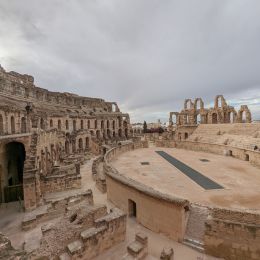If you’re staying in the Sousse area of Tunisia, or even exploring the country, then there’s one place that you should insist on making it to your itinerary. And that’s El Jem, sometimes El Djem. This is the only Roman Amphitheater in Africa that was built on flat ground, and it’s also the third largest built in the world (after Rome’s Coliseum and the now ruined theatre of Capua in Southern Italy). The Roman amphitheater at El Jem has been on the UNESCO World Heritage list since 7 October 1979 and deservedly so. It is quite stunning. Here’s how to visit El Jem, and what you shouldn’t miss here.
THIS POST MAY CONTAIN COMPENSATED AND AFFILIATE LINKS MORE INFORMATION IN OUR DISCLAIMER
El Jem is often visited on a day trip from Sousse, Monastir, Hammamet, and even Tunis. Truly, this place is spectacular and has a magnificent history that you can almost feel seeping into you as you explore it.
Here’s the easy bit. Want to see El Jem? Here are the best day trips to get there
- Go on a day trip to El Jem from Sousse
- Take a day trip from Hammamet to El Jem
- Visit El Jem on a day trip from Tunis
What is El Jem
The El Jem that you’ll want to visit is the Heritage-listed 3rd-century Roman Amphitheater, and it sits within the town of El Jem, which makes it easier to visit. Towns having public transport links and all that. More correctly, what you will want to visit is the Amphitheater of El Jem. You’ll often see El Jem written as El DJem, and both spellings are used in English, but for this article, I’ll use El Jem.
EASIEST WAY TO VISIT
Day trips to El Jem include all transport, a local guide and they’ll get you to the most important places in comfort. Some, including this one, include a visit to the Holy city of Kairouan.
Where is El Jem?
El Jem is located within the Madhia Protectorate in Tunisia, to the south of Sousse.
The site is
- 200 kilometers (124 miles) south of Tunis
- 60 kilometers (37 miles) north of Sfax
- 70 kilometers (44 miles) inland from the coastal cities of Monastir and Sousse
- 45 kilometers (28 miles) west of Mahdia
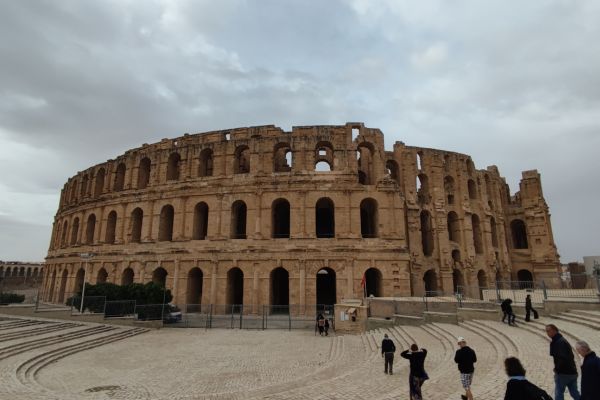
How to get to El Jem
You have a variety of ways to get to El Jem, from public transport to guided tours. However, most people who visit independently visit from either Monastir or Sousse, so here are the ways to get from Sousse to El Jem using public transport. If you want to travel from Monastir to El Jem, then first travel to Sousse.
You can read more about the different forms of transport (public and otherwise) in my guide to Tunisian transport here.
PRACTICAL TRAVEL TIPS
- 🛡️ Get Travel Insurance: Civitatis includes medical expenses, repatriation, theft, luggage delays. No deductibles or upfront payments. Get a quote here.
- 💰 Read about the Currency in Tunisia and ATM fees.
- 🔌 Check out Tunisia’s plug, socket & power situation.
- 📶 Internet, maps and data on the go. eSims for Tunisia
How to get to El Jem from Sousse
You can get from Sousse to El Jem by louage, tour, or by train. It is the BEST day trip from Sousse you can take.
El Jem via Louage
It’s easy to take a louage, Tunisia’s shared minibuses. Get yourself to the relevant louage station and buy a ticket. Louages leave when full, so depending on the time of day that you travel, it might take a while. You’ll want to get a reasonably early start for a day trip to El Jem, which is good because that’s the best time for getting a louage. Tickets cost approximately 5-6 TND each way per seat. The louage station (El Jem Louage Station, 55 Rue De La Grande Mosquee, El Jem, Tunisia) in El Jem is a 14-minute walk to the amphitheater.
El Jem by train
The El Jem stop is on the Tunis to Sfax train line, which also connects Sousse, so it’s easy to get to El Jem from Sousse by train. It takes about 45 minutes by train from Sousse Ville to El Jem, and the train station in El Jem is just a 7-minute walk away. You can check the train timetables here. Just buy a ticket at Sousse Ville (or whichever station you are leaving from).
What’s to see at El Jem?
You’re coming here to see the enormous amphitheater – if you consider it was built to seat 35,000, then it’s going to be pretty big. And the sight of it will awe you. The second thing that will awe you is that this was built in 238 A.D., and it’s still here. And in remarkable condition. There was no mortar or concrete used in the construction, merely large stones slotted together. (Nowadays, there is some mortar used to hold together some parts of the construction.)
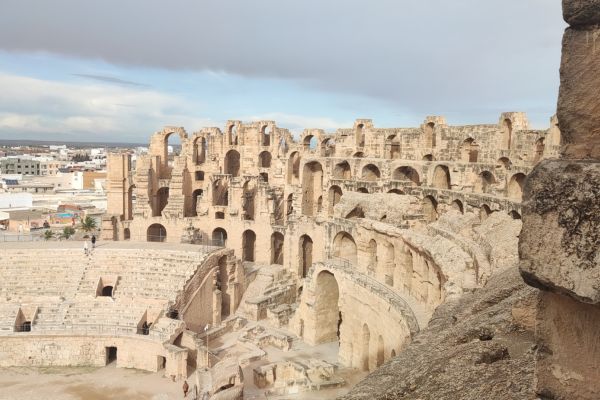
You’ll need a minimum of an hour, more like 2, to do this place justice. If you’re going to visit the museum that’s included in the ticket, add another hour.
Tickets to access the amphitheater cost 12 TND, and you buy them from the office on the way in. Your ticket includes access to the archaeological museum too. You’ll need to pay cash for this ticket – read my guide to cash, ATMs and currency in Tunisia here.
There’s no set route to explore, and no right way to see it, but you’ll want to see it all. I would start from the top, as it gives you an overview of the entire site. It’s best to pick a direction, clockwise or anti-clockwise, so you don’t miss anything, but you’ll also want to go around the site several times, as it’s on multiple different levels. It’s a very different experience seeing it from the top and then the bottom. But you also shouldn’t miss the underground passages either!
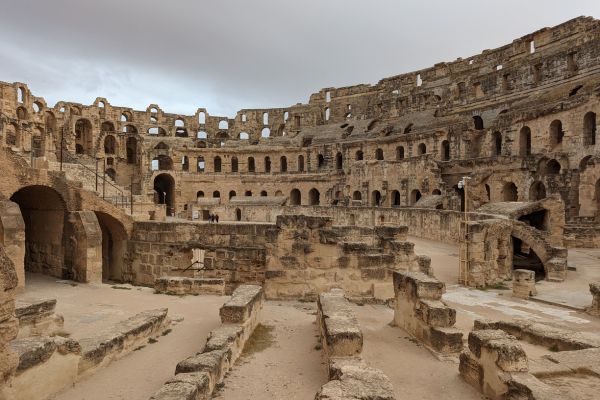
The arena is bordered by a 3.5-meter-high wall, which contains small doors opening onto a service corridor. There were also two large doors, at the ends, through which religious processions preceding the events held in the amphitheater used to pass.
In the central part of the amphitheater, a large opening provided air and light for the basement, and two trap doors were opened, and a pulley was used to lift the animal cages to the arena level.
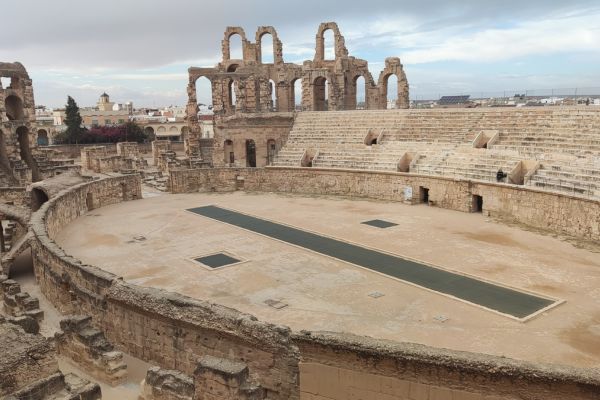
The amphitheater measures 148 meters × 122 meters. The arena itself is 64 meters × 39 meters, and the external perimeter of the amphitheater is 427 meters with a height of 36 meters.
So make sure you see
- Climb to the top level seats – and take a view back down. It’s here that you can see the hierarchy of Roman amphitheater seating, carved right into the stones. The cheap seats were higher up, and the Roman elite sat close to the action.
- Circle the amphitheater at all the different levels – you get a very different perspective. The vaulted passageways that encircle the arena are spectacular in their construction, and you will likely have them to yourself.
- Go to the Hypogeum – the underground chambers. There are two connected underground passages – these are the areas where the animals and gladiators would have gone from their housing to the arena for battle. You can see the places where the iron gates would have separated gladiators from animals. Touch the niches where oil lamps would have illuminated the passages.
- Animals used during these times for the “events” included lions, tigers, and wild boars.
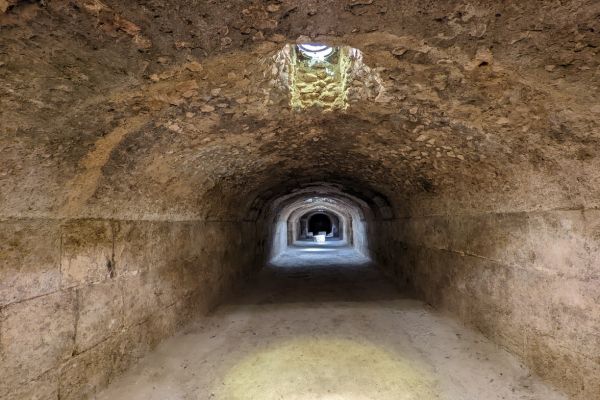
The chances are that you’ll pretty much be by yourself in the amphitheater. This isn’t like Rome; you don’t have to fight for your space for photos. When we visited, there were 12 people on the entire site. As you can guess, it was pretty easy to find a quiet space!
There are three different levels here at El Jem, don’t miss any of them. Each of these levels originally had 30 arches, a total of 90. Of those 90, 68 remain. Not even the Colosseum in Rome can claim that!. The tiers of seats (gradins) are built on a slope that is supported by the walls, vaults, and staircases.
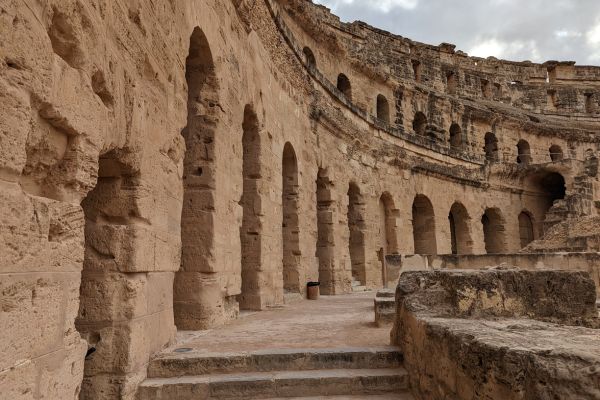
Practical information for visiting El Jem
- Ticket costs for El Jem: 12 TND (cash only)
- Time to Visit: 90 minutes – 2 hours
- Opening hours: May 1 to September 15, from 07:30 to 19:00, Winter from 08:00 to 17:30.
- Louage Station distance from El Jem: 14-minute walk
- Train Station distance from El Jem: 7-minute walk
Don’t miss the El Djem Archeological Museum
Your ticket to El Jem includes access to the museum, which is 850 meters away and a 12-minute walk (and it’s well worth the visit). There are signposts from the amphitheater to get there. The museum was created in 1970 and expanded in 2002.
The museum holds a phenomenal collection of very well-preserved Roman mosaics, many of which are stunning. Even if you’ve been to the Bardo National Museum in Tunis, you’ll be stunned by how well-preserved these mosaics are.
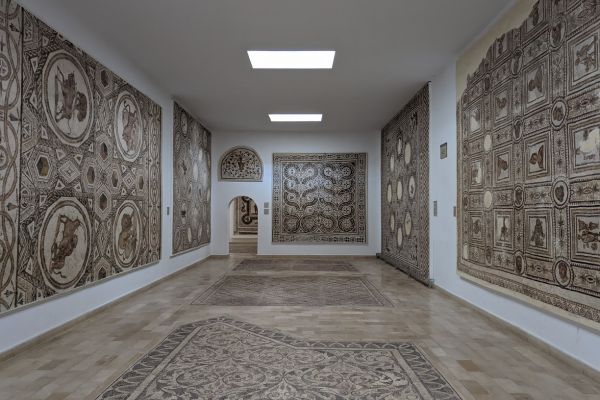
The pièce de résistance here is out the back of the museum. It’s the remains of three Roman-era villages, the House of the Peacock, an outstanding villa from the south-east of El Jem, and the House of the Dolphins (you’ll understand the name when you see the mosaic that was found here). This house also had a mosaic that included a mosaic called the “Damnatio ad Bestias,” which shows light-skinned slaves, possibly Germanic prisoners, who had been bought to be thrown to the animals in the amphitheater.
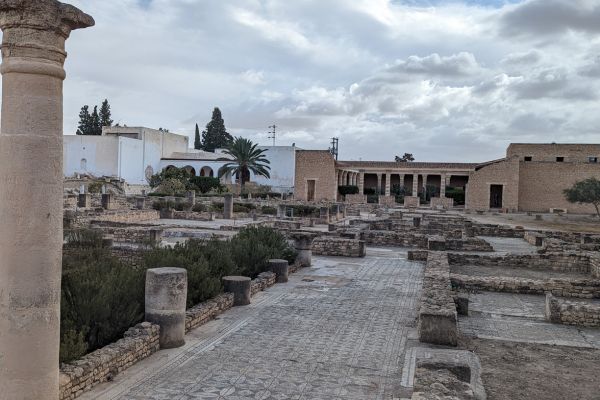
The biggest house here is the House of Africa. It was discovered in the 1990s, and is a large residence and thermal complex totally an area of 3,000 square meters. It’s been reconstructed here in the back of the museum. The name comes from one of the pavement mosaics, which is dedicated to the goddess Africa. This particular Roman Villa dates back to AD170.
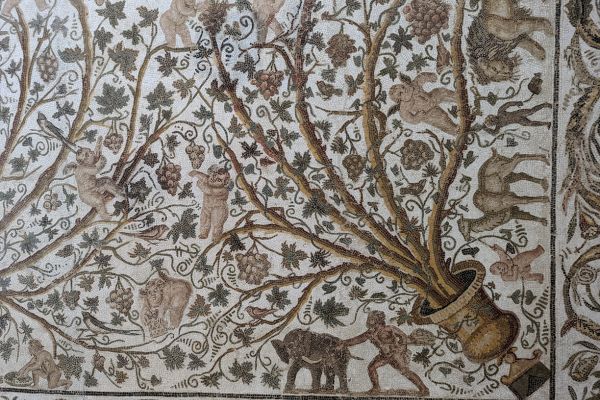
Practical information for visiting the Archeological Museum in El Jem
- Ticket costs: included in your ticket to El Jem
- Time to Visit: 30-60 minutes
- Opening hours for Museum: May 1 to September 15, from 08:00 to 18:30, Winter from 08:00 to 17:30. Ramadan: 08:00 – 17:00
- Louage Station walking time from Museum: 14-minute walk
- Train Station walking time from Museum: 6-minute walk
A Brief History of El Jem
El Jem was originally a Roman city named Thysdrus, which was built on a former Punic settlement. This was an important center of Olive oil production and export. El Jem’s amphitheater was built in the early 3rd century, and at that time, Thysdrus was a similar size to Sousse, which was then called Hadrumetum.
It’s thought that El Jem was built at the behest of Gordian, a local Roman proconsul (basically someone who had delegated authority to rule on behalf of Rome). At the time (238 AD), it was a period of instability in Roman history, known as the Crisis of the Third Century, the Military Anarchy, or the Imperial Crisis. It was at this time that the Roman Empire almost collapsed as a result of a combination of civil wars, economic issues, and foreign invasions. It is with a wry smirk that I wrote that construction projects like this of the El Jem amphitheater were often seen as tools of political propaganda. And so Proconsul Gordian declared himself Emperor Gordian I in a short-lived revolt against Emperor Maximinus Thrax. Gordian I didn’t last long, just 22 days! He committed suicide after the death in battle of his son, Gordian II. They hold the notable record of the shortest and second shortest reign of any Roman Emperors.
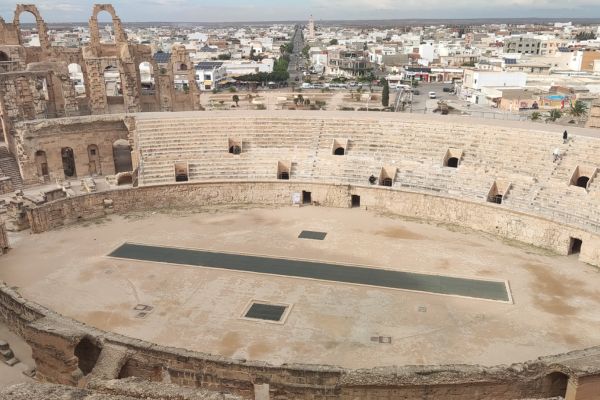
Over the centuries, El Jem has been used as a fortress and sanctuary for locals from attacks, like that of the Vandals in 430 and the Arabs in 647. Part of the western wall was blown up at the end of the 17th century at the time of the Revolution of Tunis in an attempt by Mohamed Bey El Mouradi to see off the local tribes led by his brother Ali Bey al-Muradi.
Some blocks from the amphitheater were even used to build local houses, or parts of Kairouan’s Great Mosque. Tagging on a visit to Kairouan while you’re here in El Jem is a great idea – check out my guide to Kairouan here.
As late as the 19th century, the amphitheater was used for grain storage, dwellings, and shops. It’s also been used, like the Ribat in Monastir, as a filming location for Monty Python’s Life of Brian.
TUNISIA TRAVEL RESOURCES
AIRPORT TRANSFERS
24/7 pickup & drop off. Trusted, local English speaking drivers. Prebook & prepay online with cards.
Book a Transfer
HOTELS AND APARTMENTS
See choices here
Sea view rooms? Budget rooms? Need a washing machine? The best choice of hotels & apartments.
TOURS & ATTRACTIONS
Most excursion choices, small group tours, skip-line tickets, free cancellation and top local guides.
Top options here.
CAR RENTAL OPTIONS
Choose cars here
Best choice of vehicles, automatics, large or small cars, child seats. Book early for more options.
Final Words on How to Visit El Jem
The stunning El Jem is an incredible site in central Tunisia. It’s one of the most stunning man-made places I’ve ever visited. That so much of it remains, from a build date of 238 AD, is phenomenal. And that we visited, and I know you will too, and hardly see another visitor is equally stunning. This UNESCO World Heritage site in Tunisia deserves way more visitors than it receives. Make sure one of them is you!
ASocialNomad is a participant in the Amazon Services LLC Associates Program, an affiliate advertising program designed to provide a means for sites to earn advertising fees by advertising and linking to amazon.com, amazon.co.uk, and amazon.ca. Amazon and the Amazon logo are trademarks of Amazon.com, Inc. or its affiliates. As an Amazon Associate, I earn from qualifying purchases.

